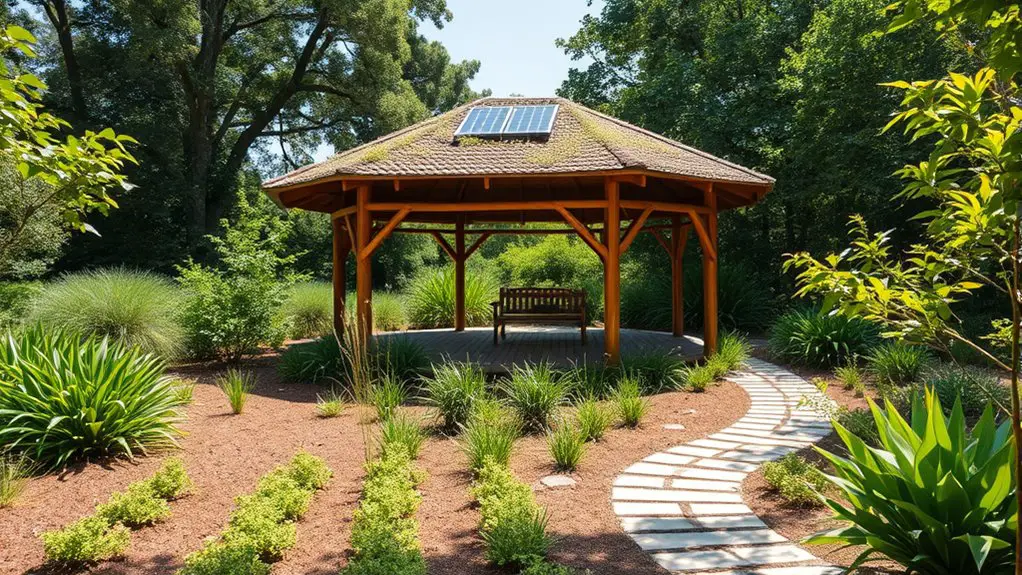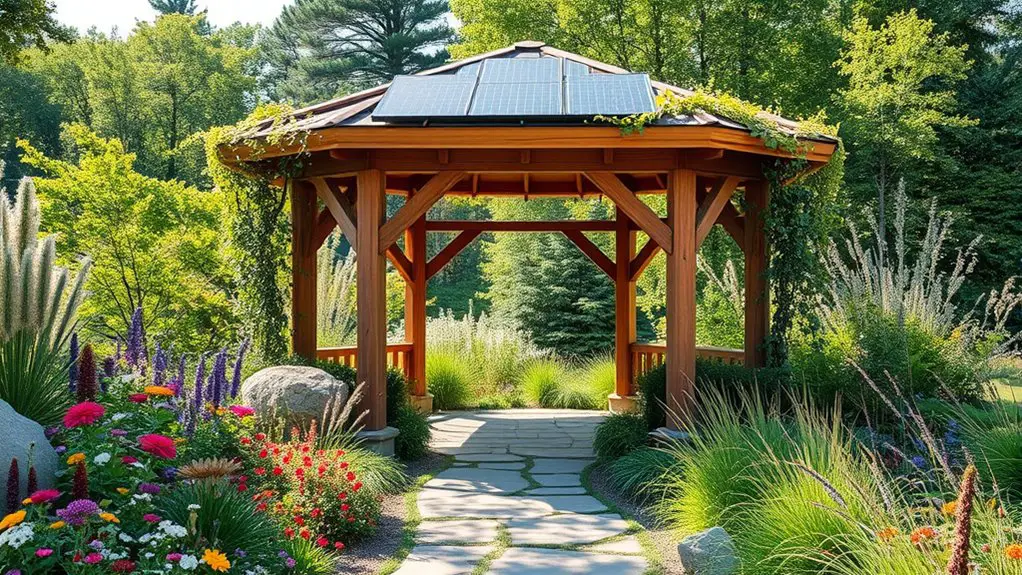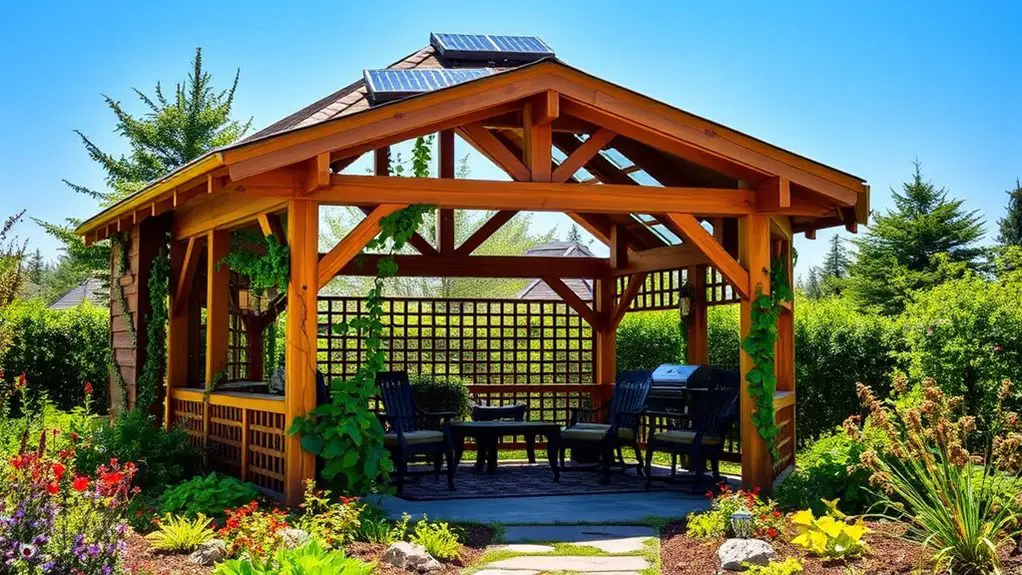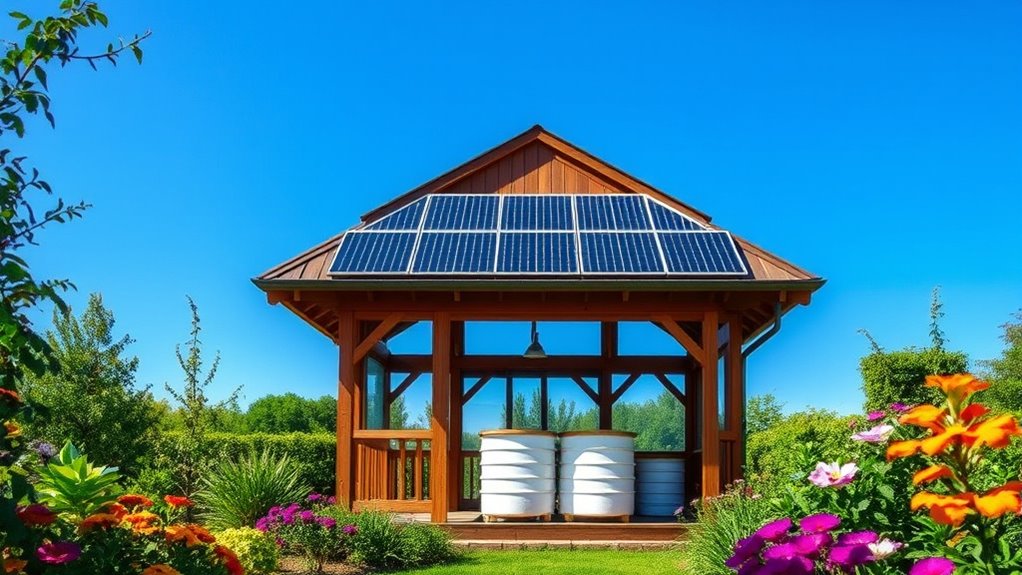To design an energy-efficient gazebo, start by selecting sustainable materials like reclaimed wood or bamboo, which reduce your environmental footprint. Maximize natural light with large windows and skylights for better ventilation. Incorporate green landscaping with native plants and permeable walkways to support local ecosystems. Install energy-efficient features such as solar panels and rainwater harvesting systems. Finally, guarantee your gazebo is adaptable for different seasons with adjustable shades and quality insulation. You’ll uncover more tips and tricks as you explore further.
Choosing Sustainable Materials

When you’re designing an energy-efficient gazebo, choosing sustainable materials is essential, as it not only reduces your environmental footprint but also enhances the structure’s longevity. Start by considering recycled materials; they’re not just eco-friendly but often add unique character to your gazebo. Think reclaimed wood or metal scraps, which can create a rustic charm while minimizing waste.
Local sourcing is another key factor. By selecting materials from nearby suppliers, you cut down on transportation emissions and support your community. This approach fosters a connection to your environment, making your gazebo a true reflection of its surroundings.
Incorporating bamboo or sustainably harvested timber can also elevate your design, providing durability without sacrificing style. Additionally, opting for naturally resistant wood types can further enhance the longevity and sustainability of your gazebo. Remember, every choice you make can express your commitment to freedom and sustainability, allowing you to enjoy your outdoor space guilt-free. So, embrace these innovative materials and craft a gazebo that stands the test of time.
Maximizing Natural Light and Ventilation
While you design your gazebo, maximizing natural light and ventilation can greatly enhance its energy efficiency and comfort. Incorporating large windows or skylights not only floods your space with natural lighting but also promotes air circulation, making your gazebo a rejuvenating retreat. Consider the placement of your structure; orient it to capture prevailing breezes and sunlight effectively. Additionally, proper installation ensures safety and longevity, which is essential for enjoying your gazebo year-round with increased property value as a bonus.
Here’s a quick guide to help you choose design elements:
| Element | Benefits |
|---|---|
| Large Windows | Increases natural lighting |
| Skylights | Enhances air circulation |
| Open Design | Promotes airflow and spaciousness |
Using these strategies, you’ll create an inviting atmosphere that harmonizes with nature. Embrace the freedom of open spaces and let the natural elements work for you, providing a serene escape that’s both beautiful and sustainable.
Incorporating Green Landscaping

Incorporating green landscaping not only beautifies your gazebo but also enhances its energy efficiency by creating a natural buffer against temperature fluctuations. By choosing native plants, you’ll support local ecosystems while reducing the need for additional watering and maintenance. These plants are adapted to your local climate, ensuring they thrive without excessive water use, promoting water conservation.
Consider strategically placing trees and shrubs around your gazebo to provide shade during hot months, keeping the area cooler and reducing your need for artificial cooling. Ground cover plants can also help retain soil moisture, further supporting your landscaping’s sustainability. Additionally, using permeable materials for walkways allows rainwater to seep into the ground, nourishing your plants while reducing runoff. By integrating these thoughtful elements into your gazebo’s landscape, you’ll not only create a serene retreat but also contribute to a healthier environment, embracing the freedom of living in harmony with nature. Furthermore, this shaded area promotes outdoor activities by enhancing comfort during various weather conditions.
Installing Energy-Efficient Features
To maximize your gazebo’s energy efficiency, consider installing features that harness natural resources and minimize energy consumption. One innovative option is solar panels. By placing them on the roof, you can generate clean energy to power lights or small appliances, allowing you to enjoy your space even after sunset without relying on the grid.
Additionally, implementing a rainwater harvesting system can be a game-changer. Collecting rainwater in a barrel not only conserves this precious resource but also provides you with water for watering plants or cleaning the gazebo, reducing your reliance on municipal water sources. Furthermore, the use of energy-efficient lighting can significantly lower energy consumption while enhancing ambiance during nighttime gatherings.
These eco-conscious features not only enhance your gazebo’s sustainability but also empower you to live more freely in harmony with nature. By integrating solar panels and rainwater harvesting, you’re not just creating a beautiful space; you’re contributing to a healthier planet while enjoying your outdoor oasis.
Planning for Seasonal Adaptability

When planning your gazebo, it’s essential to reflect on how it will adapt to the changing seasons. By incorporating seasonal features, you can maximize comfort and utility throughout the year. Here are four key climate considerations to keep in mind:
- Adjustable Shades: Install retractable screens or awnings to provide shade in summer while allowing sunlight in during winter.
- Insulated Materials: Use eco-friendly insulation to maintain a comfortable temperature, reducing energy needs in colder months.
- Heating Options: Consider installing a wood-burning stove or electric heaters for cozy gatherings in fall and winter.
- Ventilation Systems: Implement natural ventilation solutions, such as operable windows, to promote airflow during warm weather.
Additionally, ensuring that your gazebo is constructed from durable materials will enhance its resilience against various weather conditions, further contributing to its energy efficiency. Embracing these elements will not only enhance your gazebo’s functionality but also reflect your commitment to sustainability and freedom in outdoor living.
Frequently Asked Questions
What Size Gazebo Is Best for Energy Efficiency?
When it comes to energy efficiency, you’ve got a choice: small gazebos create cozy retreats, while large gazebos offer expansive spaces. Consider your needs, but smaller designs often reduce energy use and enhance comfort.
How Can I Reduce Energy Costs for Gazebo Maintenance?
To reduce energy costs for gazebo maintenance, consider installing solar panels for sustainable power and implementing rainwater harvesting systems. These eco-friendly choices not only cut expenses but also enhance your outdoor freedom and enjoyment.
What Location Is Ideal for an Energy-Efficient Gazebo?
So you’re not planning to build your gazebo in a dark cave, right? For ideal sunlight exposure and favorable wind direction, choose a spot with ample natural light, avoiding areas where the breeze just won’t blow.
Are There Specific Colors That Improve Energy Efficiency?
Certain colors can enhance energy efficiency! Light shades reflect sunlight, keeping your space cooler. Embrace color psychology by using reflective materials, like whites or pastels, to maximize comfort while promoting an eco-conscious atmosphere. Enjoy your airy retreat!
How Can I Ensure My Gazebo Meets Local Energy Codes?
Isn’t it essential to know your local building and energy regulations? To guarantee compliance, consult your municipality’s guidelines, incorporate sustainable materials, and consider energy-efficient designs that align with eco-conscious practices, giving you the freedom to create responsibly.

